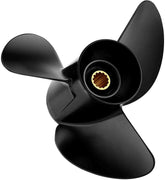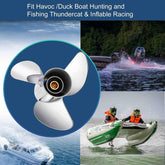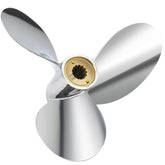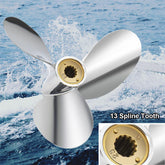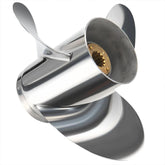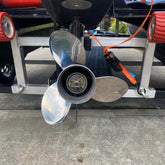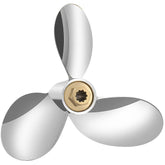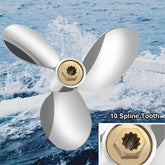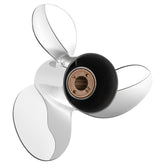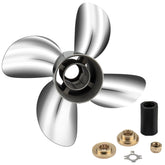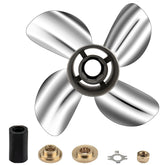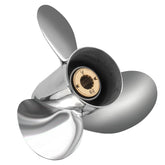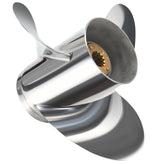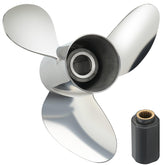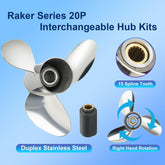How Far Under the Boat Should the Propeller Reach?
I've spent years working with boats, and I can tell you that one easily overlooked detail can make or break your boating experience: propeller depth. It might sound like a minor technical concern, but trust me, this little factor touches everything from how much fuel you burn to how your boat handles on the water.
Propeller positioning is so crucial; let me break it down to the tee, and get it just right for your particular vessel. By the time you are done reading, you'll have an understanding that is more than a textbook understanding.
Why Propeller Depth Matters
Think of your boat's propeller like the shoes on an athlete. The wrong fit means poor performance, potential damage, and a whole lot of frustration. Getting the depth right isn't just about technical precision—it's about maximizing your boat's potential.
Impact on Fuel Efficiency
What it is, is something very much sure to hit the boatsman where it hurts most: in the wallet. Ill-located propellers quietly blow your fuel budget sky high, because when propeller blades are out of the water, they create cavitation-a performance-killing bubble bath around your prop-and the result is your motor keeps hammering away, burning beaucoup fuel like there's no tomorrow.
Go too deep, and you're dragging unnecessary water resistance. Your engine will be fighting an uphill battle, consuming more power just to maintain speed. It's like trying to run through knee-deep mud—exhausting and inefficient.
Engine Strain and Longevity
Boat engines are not particularly cheap, and no person wants to replace his engine prematurely. Misaligned propellers create uneven stress on your engine that chips into its lifespan bit by bit. Think of it like wearing shoes that don't fit—eventually, your feet, or in this case, your engine, will start to wear out.
The correct depth of the prop ensures your engine runs smoothly, reducing undue wear and avoiding those extremely expensive repair bills.
Boat Handling and Stability
Your boat's maneuverability depends heavily on propeller positioning. Too deep, and you'll feel like you're driving a sluggish whale. Too shallow, and you'll experience instability that'll make even experienced captains nervous, especially when waters get choppy.
What Should the Depth Be?

In most cases, the propeller should be positioned about 3 to 5 inches below the bottom of the boat's hull. This depth allows the propeller blades to stay fully submerged, ensuring they generate sufficient thrust without excessive drag or risk of cavitation.
However, this is just a general guideline, and actual requirements can vary based on several factors, such as boat load, water conditions, and specific engine configurations. It’s essential to adjust the depth slightly depending on how the boat handles and whether the engine experiences any signs of strain.
Factors Affecting Propeller Depth
Boat Type and Size
Not all boats are created equal. A massive yacht requires a different approach compared to a small fishing boat. Larger vessels with powerful engines typically need deeper propeller placement to generate adequate thrust. Smaller boats might benefit from a shallower setup to reduce drag.
Hull design matters too. A deep-V hull demands a different approach compared to a flat-bottomed design. It's about understanding your specific vessel's characteristics.
Engine Power and Propeller Size
Your engine's horsepower isn't just a number—it's a critical factor in propeller depth. More powerful engines generally require deeper prop positioning to manage their output effectively. Propeller diameter and blade pitch play significant roles in determining the ideal depth.
Water Conditions
The water you're navigating isn't just a background detail—it's an active participant in your boating experience. Shallow waters require a higher prop placement to prevent bottom strikes. Deeper waters, saltwater, and even water temperature can subtly influence how your propeller performs.
Boat Load
Don't underestimate the impact of weight. A boat loaded with gear and passengers will sit differently in the water compared to an empty vessel. This changing dynamic means your ideal propeller depth isn't a fixed point but a flexible range.
How to Set Prop Depth in the Water

Step 1: Manufacturer's Guidelines
Start with the manual. Boat and engine manufacturers provide recommendations based on extensive testing. It's your first, most reliable reference point.
Step 2: Conduct a Test Run
Theory meets practice on the water. Watch for cavitation, unexpected speed drops, or strange engine behavior. These are your boat's way of telling you something isn't quite right with the propeller positioning.
Step 3: Monitor Engine Performance
Listen to your engine. Unusual strain or sluggish response means it's time to adjust. Your engine's RPMs tell a story—learn to read them.
Step 4: Evaluate Boat Handling
A well-positioned propeller translates to smooth, predictable handling. If your boat feels like it's fighting you, your propeller depth needs attention.
Step 5: Fine-Tune the Trim
Trimming isn't just a final step—it's an art. Experiment with different angles to find that sweet spot between speed, efficiency, and control.
Conclusion
Getting your boat's propeller depth right isn't about perfection—it's about continuous improvement. Each adjustment brings you closer to that ideal balance of performance, efficiency, and enjoyment.
Your boat is not just iron; it's a system where even a small component like the propeller plays an important role. The more time you take to understand it, the more rewards you will get in terms of smooth rides, less fuel bills, and less surprise maintenance.
Happy boating!


